- Регистрация
- 17 Февраль 2018
- Сообщения
- 25 397
- Лучшие ответы
- 0
- Баллы
- 2 093
Offline

Expert's Rating
Pros
- Excellent multithreaded CPU performance
- Beautiful OLED screen
- Discrete Nvidia GPU for creative tasks
- “AI PC” hardware with traditional x86 application compatibility
- Lower battery life than a Snapdragon X laptop
- Fans can be loud
- No Copilot+ PC AI features at launch
The Asus ProArt PX13 is a creator-focused laptop with impressive CPU performance thanks to its AMD Ryzen AI 300 series hardware. But, while this x86 machine has power and beauty, AMD’s latest hardware still falls behind Arm PCs when it comes to fan noise and battery life.
The Asus ProArt PX13 is a portable PC intended for creators. It’s one of the first laptops out there with the new AMD Ryzen AI 9 HX 370 processor. New CPU aside, this PC packs lots of other useful features for creators, including a dedicated Nvidia RTX 4050 GPU, 32GB of RAM, and a beautiful OLED display with a touchscreen that also supports pressure-sensitive stylus input. It has a 360-degree hinge so you can lie it flat, too.
This is a high-quality PC for creators, and that AMD Ryzen hardware takes it to the next level. As we’ve already seen in some of our AMD Ryzen AI 300 benchmarks, this is “pretty, pretty, pretty darn good” hardware from AMD.
Asus ProArt PX13: Specs
The Asus ProArt PX13 has impressive specs. It includes a AMD Ryzen AI 9 HX 370 CPU as well as a whopping 32GB of RAM, ensuring plenty of memory for creative applications.
AMD’s Ryzen AI platform includes a neural processing unit (NPU) with “up to 50 TOPS” (trillion operations per second) of performance. This means it beats the NPU in those Snapdragon X-powered Copilot+ PCs – at least on paper. And, unlike those Snapdragon X Elite and Snapdragon X Plus-powered laptops, this machine is a traditional x86 computer with full compatibility with traditional Windows software – no Prism translation layer required.
On top of that, you get a discrete Nvidia GPU. The $1,699 base model we reviewed includes an Nvidia RTX 4050 GPU, while Asus also sells a $1,999 model that comes with an Nvidia RTX 4060 GPU. A discrete Nvidia GPU like this one will be something many creative professionals are looking for, whether they’re doing graphical rendering or local AI tasks. This is yet another feature that Arm-powered Windows PCs don’t offer – with Snapdragon, you’re limited to the onboard Qualcomm Adreno GPU.
It’s worth noting that the Asus ProArt PX13 does not include a pen. You’ll have to buy a pen like the Asus Pen 2.0 separately to take advantage of the screen’s stylus support.
- CPU: AMD Ryzen AI 9 HX 370
- Memory: 32GB LPDDR5X 7500 MHz
- Graphics/GPU: Nvidia RTX 4050, AMD Radeon 890M
- Display: 13.3-inch 2880×1880 OLED display with 60Hz refresh rate, touchscreen, stylus support
- Storage: 1 TB PCIe 4.0 SSD
- Webcam: 1080p webcam
- Connectivity: 2x USB Type-C (USB4), 1x USB Type-A (USB 3.2 Gen 2), 1x combo audio jack, 1x HDMI 2.1, 1x microSD reader, 1x power in
- Networking: Wi-Fi 7, Bluetooth 5.4
- Biometrics: IR camera for facial recognition
- Battery capacity: 73 Watt-hours
- Dimensions: 11.74 x 8.26 x 0.7 inches
- Weight: 3.04 pounds
- MSRP: $1,699 as tested
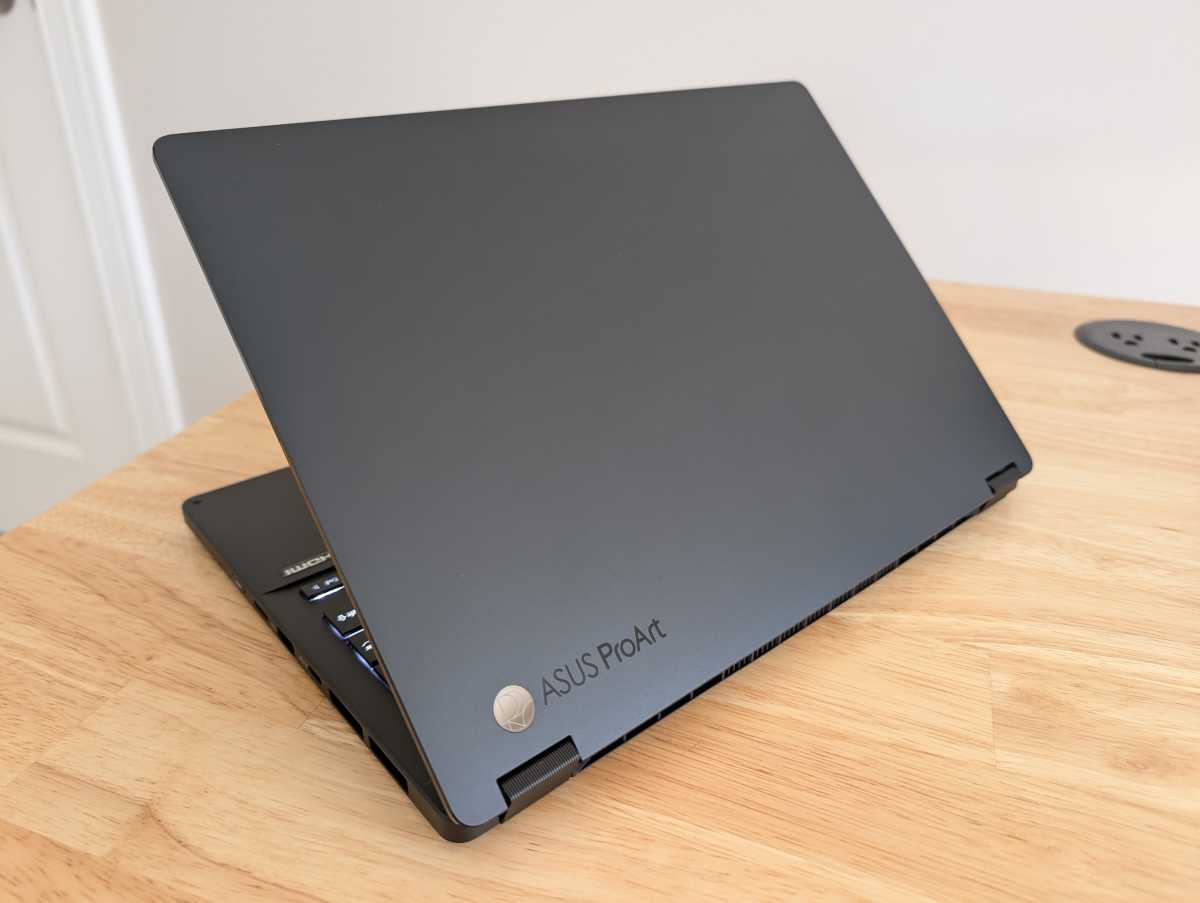
IDG / Chris Hoffman
IDG / Chris Hoffman
IDG / Chris Hoffman
The Asus ProArt PX13 has great build quality with an all-aluminum chassis. The hinge works well – it’s easy to open with one hand and the screen doesn’t move or wobble as you type. The all-black design looks good to me, with an elegant “Asus ProArt” logo on the lid. It has a 360-degree hinge so you can rotate it into a “tent” mode or lie it flat on a surface for drawing.
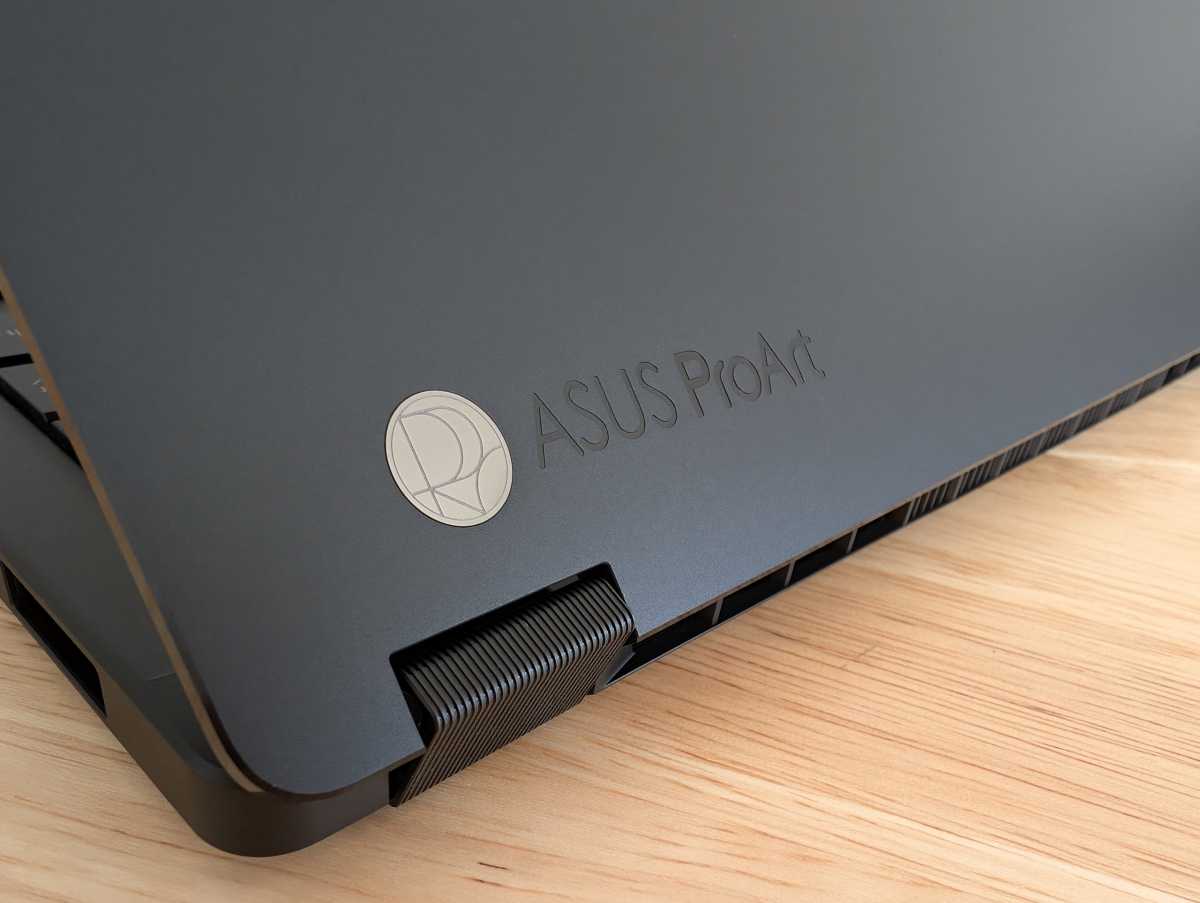
IDG / Chris Hoffman
IDG / Chris Hoffman
IDG / Chris Hoffman
Asus touts the laptop’s “nano black” finish, stating that its “anodizing process creates a nano-microporous structure that minimizes reflections, ensuring the laptop’s sleek ultra-black appearance in any lighting.” Asus also goes out of the way to tout the hydrophobic nature of the coating, stating that it produces a “smudge-resistant finish” that repels fingerprints. It all adds up to a very nice, premium-looking finish.
Starting at $1,699 with all this hardware — the screaming-fast AMD CPU, vivid OLED screen, discrete Nvidia GPU, 32GB of RAM, and 1TB of storage combined with nice build quality — it’s a compelling package if you’re looking for a 13.3-inch laptop.
This 13.3-inch laptop is 3.04 pounds, which is just barely heavier than Snapdragon X-powered laptops like Microsoft’s Surface Laptop. It’s nice and portable. Considering this is a traditional x86 laptop that packs a discrete Nvidia GPU, that’s impressive. It feels solid and well-made.
This PC has very effective fans, but they can be very loud. It isn’t the kind of “cool and quiet” everyday PC experience you find on an Arm-based Snapdragon X-powered PC. The fan is often audible in day-to-day computer use, unlike with a Snapdragon X-powered laptop.
Asus ProArt PX13: Keyboard and trackpad

IDG / Chris Hoffman
IDG / Chris Hoffman
IDG / Chris Hoffman
The Asus ProArt PX13 has an impressive chiclet keyboard that feels great to type on. It’s one of the snappier keyboards I’ve used outside of a mechanical keyboard. The laptop’s key travel distance of 1.7mm plays an important role here, I’m sure. There’s nothing mushy about the action on this keyboard. It’s a well laid-out keyboard with white backlighting and the obligatory Copilot key for launching Microsoft’s AI chatbot.
The Asus ProArt PX13 has a trackpad with an interesting feature. The trackpad itself is a good size that feels pleasant to use and swipe your finger over, and palm rejection isn’t a problem. Still, while it’s a nice trackpad, the click experience doesn’t feel as nice as the kind of click you’ll get on a haptic touchpad like those in Microsoft’s latest Surface Laptops.
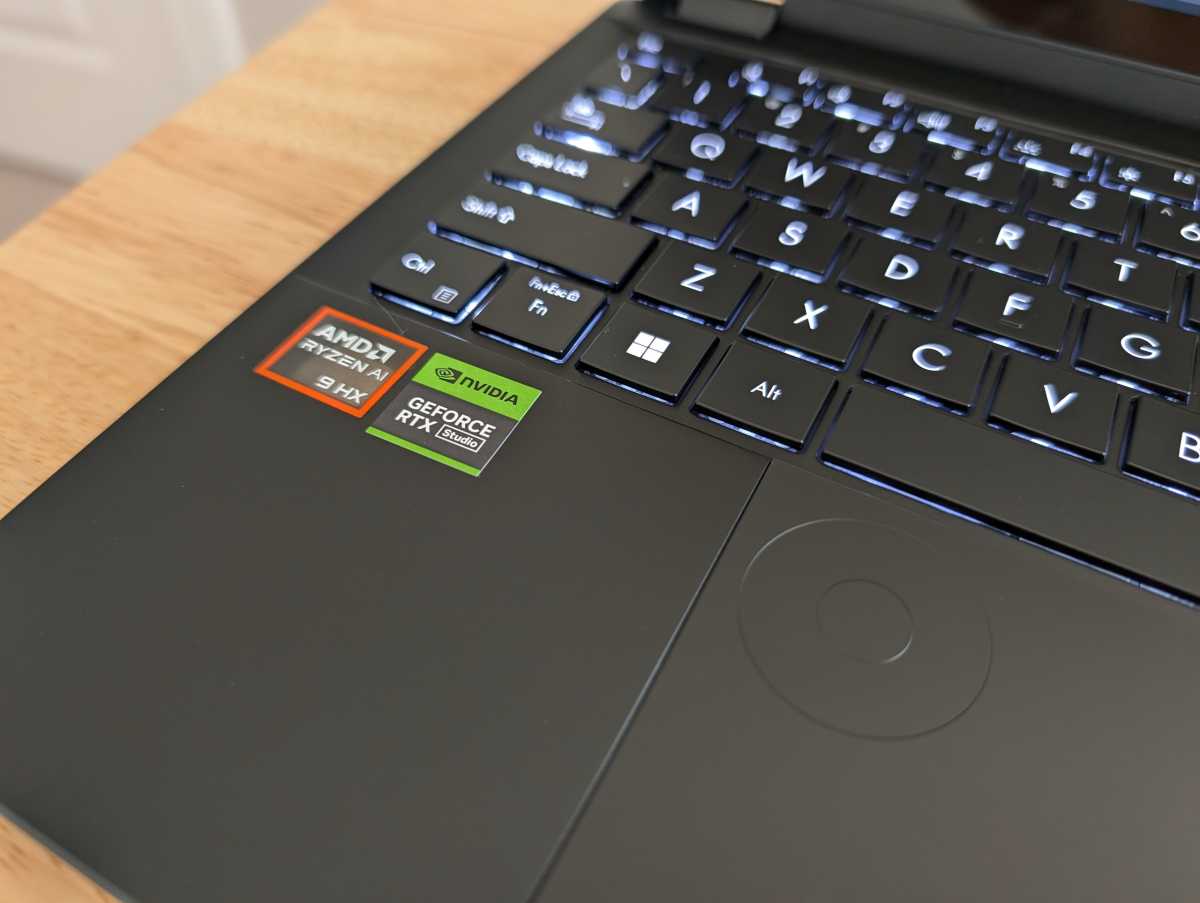
IDG / Chris Hoffman
IDG / Chris Hoffman
IDG / Chris Hoffman
The trackpad includes an “Asus DialPad” at the top-left corner. To activate the Asus DialPad, you will touch the top-right corner of the touchpad and then diagonally, down and down the left. A small LED light will turn on inside the DialPad. You can then touch and rotate it to select different options in different applications. It’s a neat feature and is incredibly customizable using the “Asus Dial & Control Panel” application included with the PC. It works in a wide variety of applications, including Adobe Photoshop. Asus sees you using the dial as a convenient way to adjust brush sizes, for example, without keyboard shortcuts or clicking around with your mouse.
Asus ProArt PX13: Display and speakers
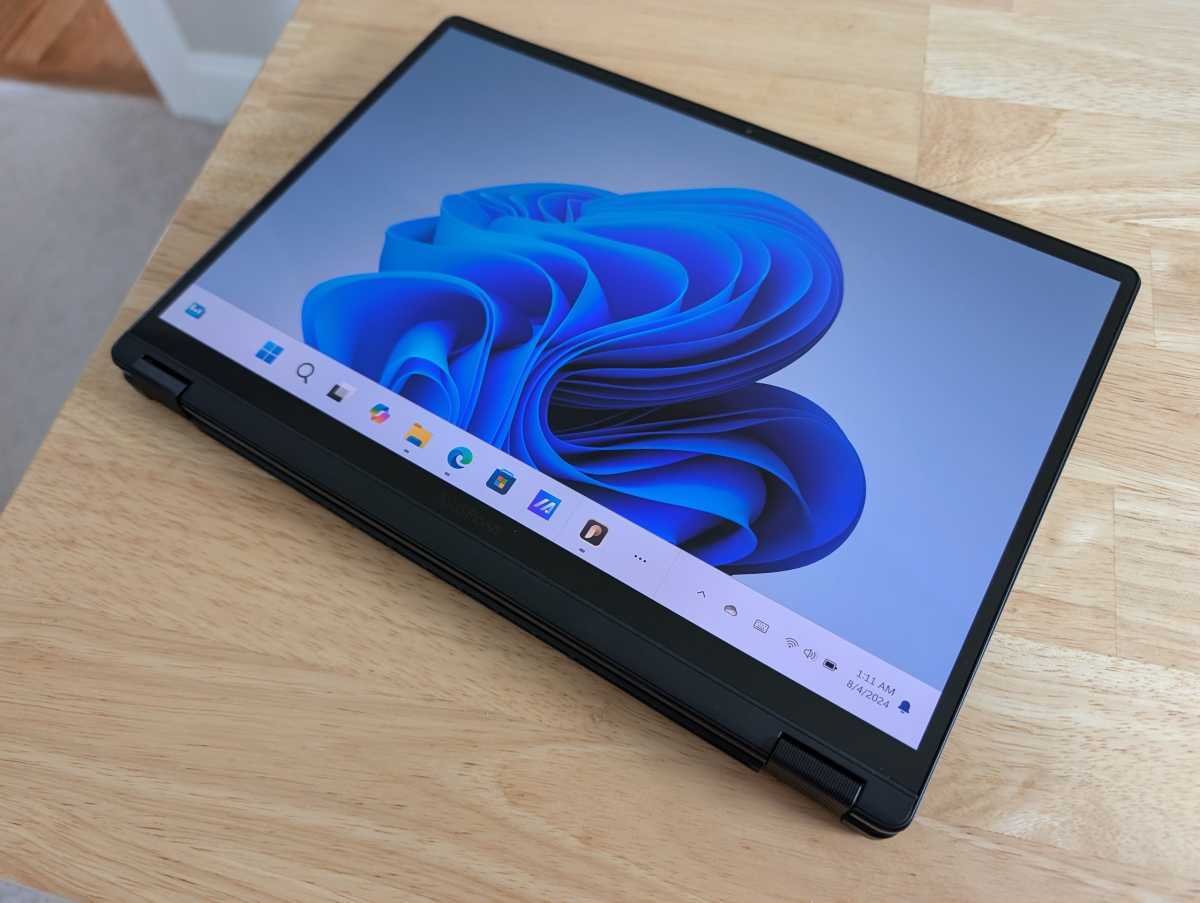
IDG / Chris Hoffman
IDG / Chris Hoffman
IDG / Chris Hoffman
The Asus ProArt PX13’s display is the star of the show. This vivid 13.3-inch OLED display delivers 2880×1880 (3K) resolution with a 60Hz refresh rate and 500 nits of peak brightness. That’s a 16:10 aspect ratio, which is great for work. It also features a touch screen and support for a stylus with multiple pressure levels – although, again, Asus does not include a stylus with this PC. That’s sold separately.
Some people will quibble with the 60Hz refresh rate. You can definitely get displays with a higher refresh rate. But this is a creator-focused laptop, not a gaming laptop. The OLED is beautiful and Asus prioritized other specs above refresh rate, which I feel is understandable. Also, this laptop already doesn’t have the longest battery life, and a higher refresh rate would further eat into it.
The Asus ProArt PX 13 has high-quality speakers. They’re “Harman Kardon” certified speakers. Asus says the speakers “output louder volumes with richer depth and better surround-sound effects, compared to laptops of a similar size.” That’s a fair assessment: They’re plenty loud and they delivered a better sound experience than the speakers in a typical 13-inch laptop when watching movies. Lack of bass is always an issue with all but the most premium of speakers in the beefiest of gaming laptops, but this laptop’s speaker setup sounds unusually good for its size.
Asus ProArt PX13: Webcam, microphone, biometrics
The Asus ProArt PX13 includes a 1080p webcam, and it looks good – I’d be happy to use it in video meetings.
There’s one surprising thing about the webcam setup: This laptop doesn’t include Windows Studio Effects, an AI-based webcam feature built into Windows that requires a neural processing unit (NPU.) This is the one AI feature I expected to find built into Windows – it was also available on Intel’s Meteor Lake laptops, which launched before Copilot+ PCs. Perhaps this feature will arrive if and when this PC becomes “Copilot+ PC” certified and gains access to other AI features built into Windows 11 in the future.
Asus says this laptop has a “built-in array microphone.” It sounds nice and clear, but it was a little on the quiet side. When I opened Windows settings to turn up the microphone volume, I found it was already turned to maximum. It’s workable, but I’m used to more volume from built-in laptop microphones out of the box.
The IR camera worked well here, using Windows Hello to sign me in with facial recognition after I opened the laptop or turned it on. This laptop does not include a fingerprint reader – facial recognition is your one option for biometrics.
Asus ProArt PX13: Connectivity

IDG / Chris Hoffman
IDG / Chris Hoffman
IDG / Chris Hoffman
The Asus ProArt PX13 has a good selection of ports. On the left, you’ve got a DC power in jack for the charter, an HDMI 2.1 port, a USB Type-C (USB4) port, and a combo audio jack.

IDG / Chris Hoffman
IDG / Chris Hoffman
IDG / Chris Hoffman
On the right, this laptop has a second USB Type-C (USB4) port, a USB Type-A (USB 3.2 Gen 2) port, and a microSD card reader slot next to the power button. That’s about what you’ll be looking for in a laptop of this size. You can always get a dongle if you need an Ethernet connection or more ports.
The Asus ProArt PX13 also includes hardware that supports Wi-Fi 7 and Bluetooth 5.4. It’s high time modern hardware platforms are including Wi-Fi 7 as a standard feature. Even if you don’t have a Wi-Fi 7 router yet, it’s good to have for future proofing.
What about Copilot+ PC features?
The Asus ProArt PX13 includes a neural processing unit (NPU) with up to 50 TOPS (trillion operations per second) of performance. This is faster than the NPUs found in the first wave of Copilot+ PCs, which are powered by Arm-based Snapdragon X Elite or Snapdragon X Plus chips.
Despite that, this PC doesn’t have any of those Copilot+ PC features – which, to be fair, are underwhelming right now anyway. As mentioned above, this PC doesn’t even include Windows Studio Effects for webcam effects, despite that package of effects being available on Intel’s Core Ultra-powered Meteor Lake laptops, which launched earlier this year.
AMD has said it expects Copilot+ PC features will arrive via Windows Update by the end of 2024, but Microsoft hasn’t publicly committed to that timeline. Microsoft has not been clear about exactly when these PCs will get Copilot+ PC features, and that’s unfortunate. With the controversial Recall feature delayed, Microsoft’s messaging around these Copilot+ PC AI features is very messy in general. The same will be true for other AMD Ryzen AI-powered laptops as well as Intel’s forthcoming Lunar Lake-powered systems.
We don’t have a great way to benchmark the performance of the NPU (neural processing unit) just yet. That’s especially true since few creative applications are using the NPU at this moment. AMD has gone out of its way to show off the NPU in some ways, bundling two applications: MuseTree is an application that gives you “inspiration,” and it will generate a tree of AI-generated images and ideas for you. StoryCube is designed to import images and video and organize them with AI. They’re interesting, and it’s nice to see Asus try to do something creative.
Asus ProArt PX13: Performance
The Asus ProArt PX13 offered great performance in day-to-day computer use. With the latest AMD Ryzen AI 9 HX 370 CPU, a discrete Nvidia GeForce RTX 4050 GPU, 32GB of RAM, and a 1TB SSD, that’s exactly what we’d expect to see – there’s no surprise there.
But just how does this x86 laptop stack up to recent offerings from Intel, like the competing Intel Core Ultra “AI PCs” with current Meteor Lake hardware? As always, we ran the Asus ProArt PX13 through our standard benchmarks to see how it performs.

IDG / Chris Hoffman
IDG / Chris Hoffman
IDG / Chris Hoffman
First, we run PCMark 10 to get an idea of overall system performance. While this benchmark is designed to be a test of holistic system performance, it’s particularly focused on the CPU.
With an overall PCMark 10 score of 7,887, the Asus ProArt PX13 blew away other creator-focused laptops in the market like the Dell Inspiron 16 Plus, which features a Intel Core Ultra 7 155H CPU. AMD’s latest Ryzen hardware is delivering some serious multithreaded performance in particular. As we demonstrated in our overall Ryzen AI 300 benchmarks, multithreaded performance is where this hardware really shines.
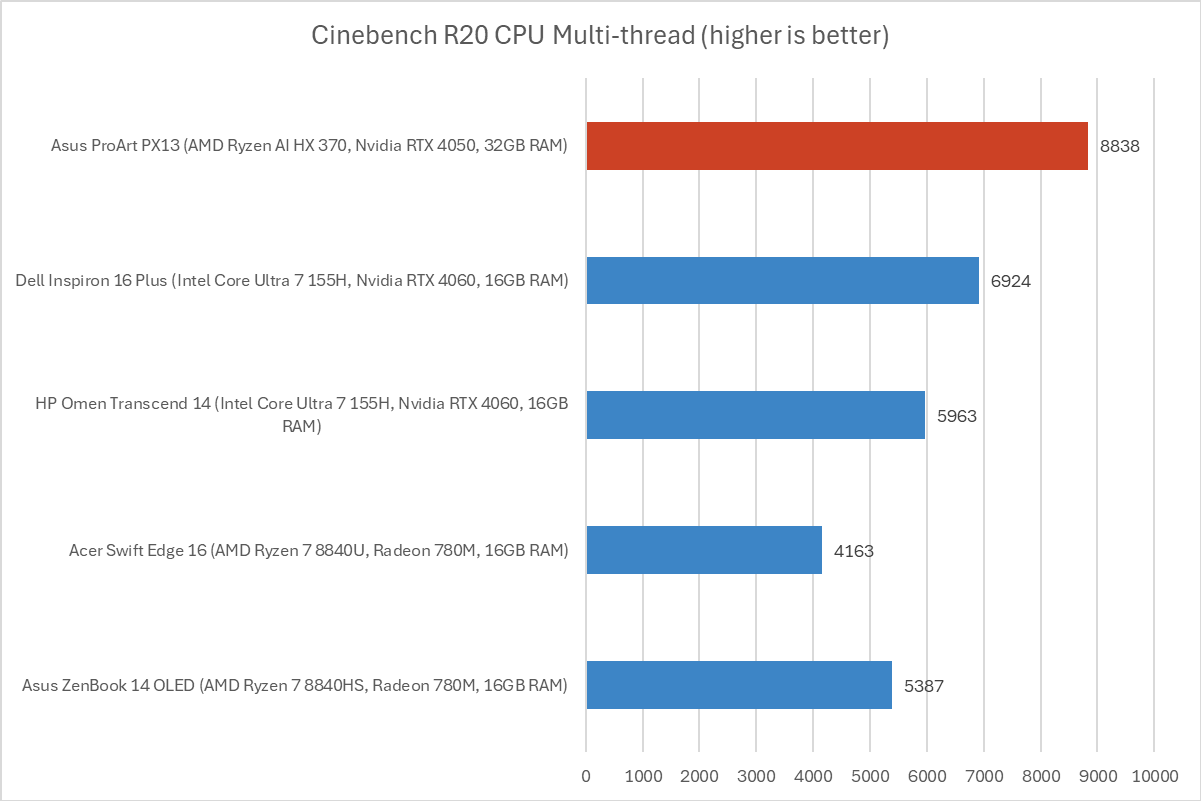
IDG / Chris Hoffman
IDG / Chris Hoffman
IDG / Chris Hoffman
Next, we run Cinebench R20. This is a heavily multithreaded benchmark that focuses on overall CPU performance. It’s a quick benchmark, so cooling under extended workloads isn’t a factor. But, since it’s heavily multithreaded, CPUs with more cores have a huge advantage.
With a score of 8,838, the Asus ProArt PX13 absolutely blew away the competition once again. This is seriously impressive performance. I hope Intel’s upcoming Lunar Lake chips delivers some serious multithreaded performance gains to compete.
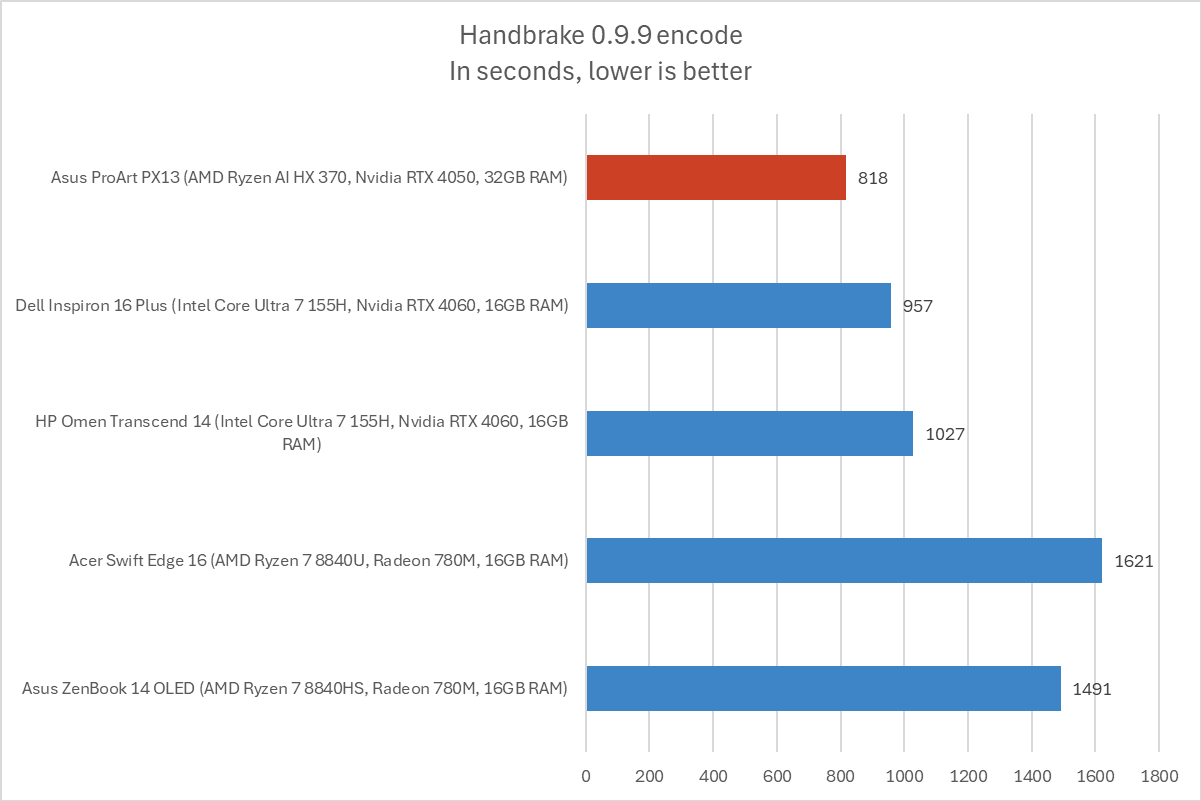
IDG / Chris Hoffman
IDG / Chris Hoffman
IDG / Chris Hoffman
We also run an encode with Handbrake. This is another heavily multithreaded benchmark, but it runs over an extended period of time. This demands the laptop’s cooling kick in and many laptops will throttle and slow down under load.
The Asus ProArt PX13 completed the encode process in 818 seconds – about 13 and a half minutes. Again, that’s significantly faster than the Intel Meteor Lake-powered PCs we compared it against.
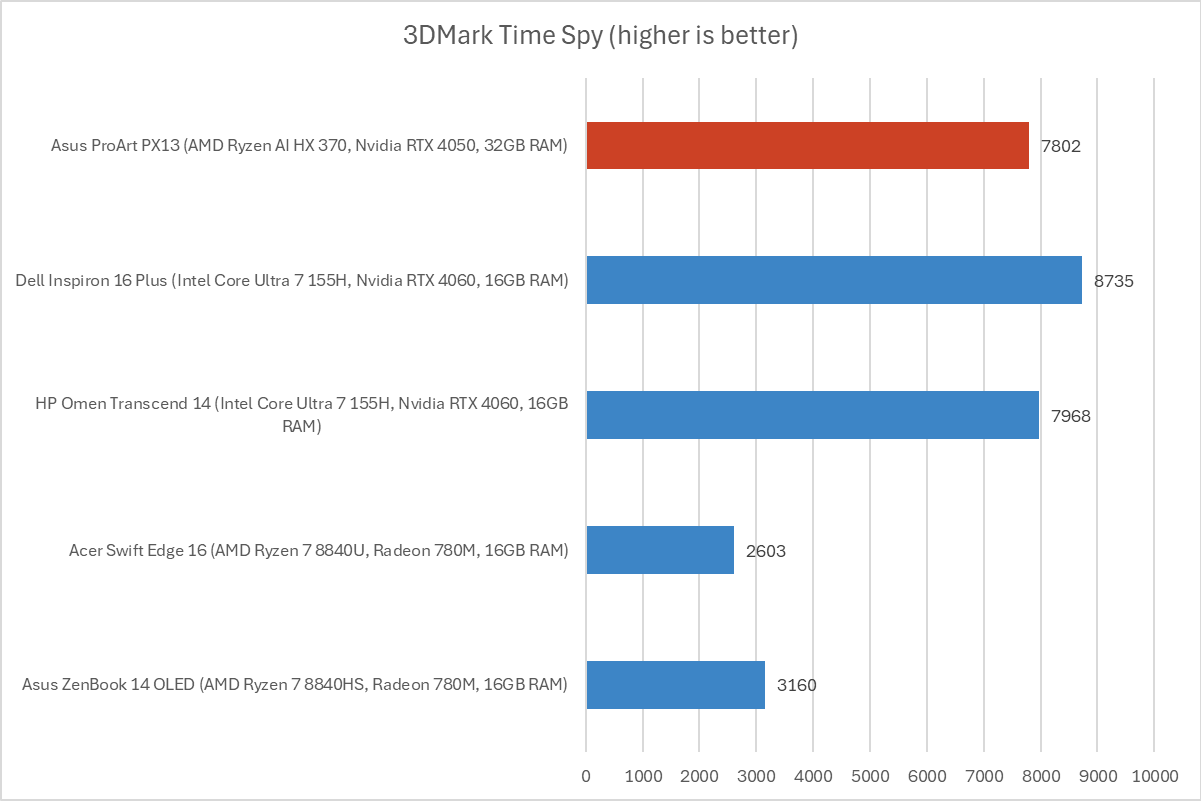
IDG / Chris Hoffman
IDG / Chris Hoffman
IDG / Chris Hoffman
Next, we run a graphical benchmark. While this has an Nvidia GPU, it isn’t a gaming laptop. You can play games on it in a pinch, naturally, but the intended use of that GPU is 3D rendering, GPU-heavy AI tasks, and other creative workloads. We run 3Dmark Time Spy, a graphical benchmark that focuses on GPU performance.
Naturally, the results here are all about the GPU. The Asus ProArt PX13, with its Nvidia GeForce 4050, fell behind some GeForce 4060-powered laptops. The version of this laptop with the GeForce 4060 would likely catch up.
Overall, performance on this laptop was excellent. AMD’s new Ryzen AI 300 series hardware is delivering serious multithreaded CPU power.
Asus ProArt PX13: Battery life
The Asus ProArt PX13 includes a 73 Watt-hour battery. While this is a new CPU from AMD and the industry is becoming more focused on battery life and power efficiency, AMD has been quieter about battery life. Qualcomm and Intel are competing on long battery life, but AMD seems to be focusing on performance.
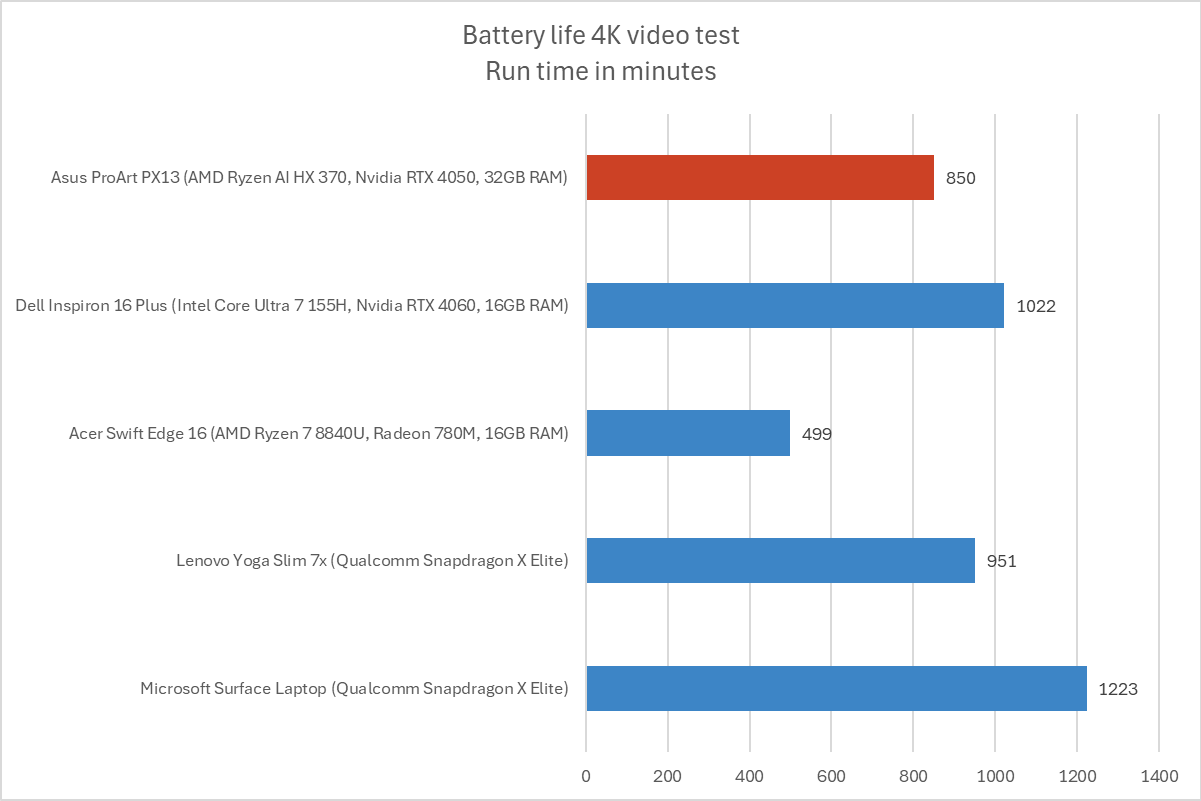
IDG / Chris Hoffman
IDG / Chris Hoffman
IDG / Chris Hoffman
To benchmark a laptop’s battery life, we play a 4K copy of Tears of Steel on repeat on Windows 11 with airplane mode enabled until the laptop suspends itself. We set the screen to 250 nits of brightness for our battery benchmarks, and it’s worth noting that the Asus ProArt PX13’s OLED display has a bit of an advantage, as OLED screens use less power to display the black bars around the video.
This is a best-case scenario for any laptop since local video playback is so efficient, and real battery life in day-to-day use is always going to be less than this.
In our battery rundown test, the Asus ProArt PX13 lasted for an average of 850 minutes – that’s just over 14 hours. While that’s a reasonable number, especially considering the OLED display and the other hardware this machine includes, it’s definitely far shorter than current Copilot+ PCs with their Qualcomm Snapdragon X Elite or Qualcomm Snapdragon X Plus hardware.
The Surface Laptop is a good example of Qualcomm’s battery life strength: It delivered 1,223 minutes of battery life in our test, which is over 20 hours. And the Surface Laptop has a smaller battery at 54 Watt-hours compared to the 73 Watt-hour battery in this PC.
Remember that, while 14 hours may sound like a lot, you’ll get less in day-to-day use as you actually use applications on the laptop. This x86-based creator-focused laptop has a lot of positives, but it does fall behind Arm-based Snapdragon X PCs when it comes to battery life.
Asus ProArt PX13: Conclusion
The Asus ProArt PX13 is an incredible laptop. If you’re a creator looking for a high-quality machine with great build quality, the latest AMD CPU with seriously impressive multithreaded performance, a discrete Nvidia GPU, and lots of RAM, this is a great machine. It has complete compatibility with existing x86 software with no Prism translation layer slowing things down or causing occasional compatibility problems.
Starting at $1,699 with all this hardware — the screaming-fast AMD CPU, vivid OLED screen, discrete Nvidia GPU, 32GB of RAM, and 1TB of storage combined with nice build quality — it’s a compelling package if you’re looking for a 13.3-inch laptop.
But, while this machine has many of the traditional strengths of an x86 PC, it also has its traditional downsides. Battery life is lower and the fan is surprisingly loud in normal PC use. It’s normal on an x86 laptop, especially one with this type of hardware.
However, this machine isn’t for everyone. If you’ll be doing lighter work and you don’t need the high-end hardware here, an Arm-powered Snapdragon PC will deliver substantially longer battery life combined with cool and quiet operation.
If you’re not in a rush to buy a PC, you may want to wait to see reviews of Intel’s Lunar Lake hardware. Intel says it’s launching Lunar Lake on September 3, 2024. The company has been making big promises about both long battery life and incredible performance gains. We look forward to reviewing Intel’s new hardware and seeing how it compares.
